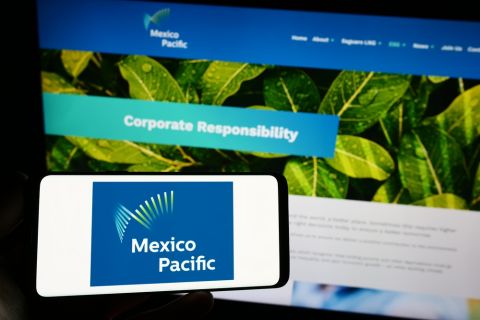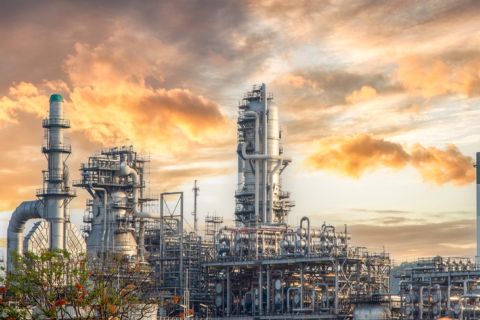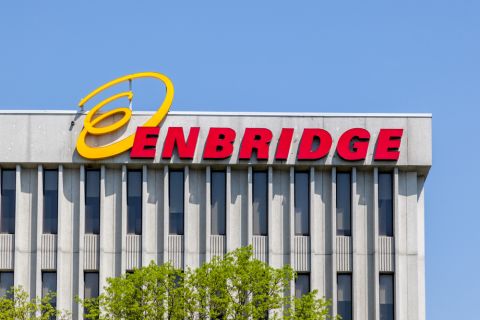
A jackup rig is towed to a location offshore. (Source: James Jones Jr./Shutterstock.com)
Continued focus on spending amid oil price volatility, coronavirus concerns and near-term demand have not stopped oil and gas explorers from pursuing barrels in deep water and frontier regions.
Looking at discoveries made across the world, frontier and deepwater finds are by far the largest, with the average deepwater discovery size around 225 MMboe compared to about 25 MMboe for onshore finds, providing opportunity for not just scale but lower costs, according to Julie Wilson, director of global exploration research for Wood Mackenzie.
Speaking during a recent OTC Live virtual session on opportunities and challenges in frontier basins and emerging offshore areas, Wilson said exploration is about enhancing the portfolio with “advantaged hydrocarbons” that have low costs and breakevens.
Point-forward costs of advantaged hydrocarbons for oil and gas under development, for example, are about $18/boe and $11/boe, respectively, according to data from Wood Mackenzie. That includes exploration, development, production and abandonment.
“If you think that, as many people do right now, in this time of capital discipline, companies are just focused on lower risk near-field exploration, I’m here to disavow you of that belief,” she said, later adding “there is still a lot of high-impact exploration happening.”
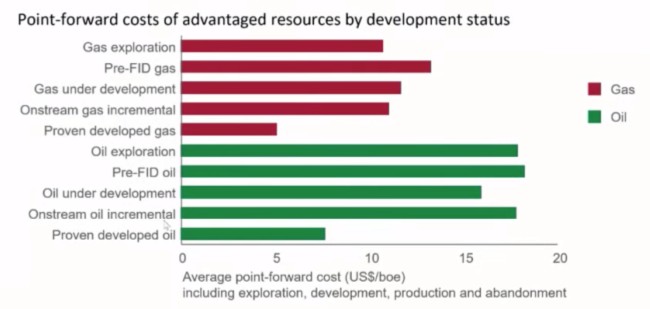
Defined as discoveries with more than 100 MMboe of resources, high-impact finds made up 85% of the total volumes discovered in 2019-2020. “Of those volumes found in 2020 alone, 60% of them are already commercially viable,” Wilson said, noting explorers are targeting prospects with clear lines of sight to commercialization.
While some companies may have slowed exploration, given stretched balance sheets, others—mostly majors and NOCs—are still drilling or planning to drill high-impact and frontier wells. These include the Total SA-operated South Platte well in the U.S. Gulf of Mexico, Total’s Blaasop-1X offshore South Africa and the BP Plc-operated Ironbark-1 well offshore Australia.
Many of those so-called advantaged barrels have been found offshore Guyana, where the Exxon Mobil Corp.-led consortium that includes Hess Corp. and China’s CNOOC Ltd. has discovered about 9 Bboe in recoverable resources on the Stabroek Block.
“Despite the noise you hear about the end of oil and gas exploration [and] the current disruption of COVID, energy demand is forecast to grow for the next two decades,” said Tim Chisholm, vice president of exploration for Hess’ Guyana and Suriname operations. “While some argue that we should not explore and develop new fields, … ongoing exploration will be critical to meeting future demand at the most efficient economic cost.”
He added investments will be driven by economics, and frontier provinces—like the Guyana-Suriname Basin—compete with other resource plays.
Meeting Demand
Referring to the International Energy Agency’s (IEA) World Energy Outlook 2020, Chisholm pointed to future rising energy demand.
“The COVID-19 crisis has significantly impacted the 2020 oil demand…but we see total energy demand returns to pre-crisis levels by 2023 with some regional variances,” he said. The world’s population is forecast to rise 21% to 9.2 million during the next 20 years with GDP growing on average 3% annually. “So that is a massive energy demand growth. … That’s equivalent to adding a further China plus India.”
Though renewables are expected to see the fastest growth, natural gas demand could rise by 30% as oil demand growth slows through 2040, Chisholm said. “Oil and gas still remain 54% of the energy demand in the IEA base case and 46% in the IEA sustainable development scenario,” which is aligned with the Paris Agreement’s objective of holding the increase in global average temperature to below 2 degrees C above pre-industrial levels.
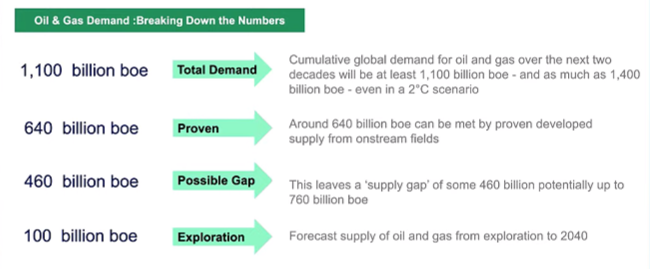
Citing Wood Mackenzie’s data, Chisholm added that demand under the sustainable development scenario would be 1.1 trillion barrels but as high as 1.4 trillion barrels. With 640 billion barrels coming from developed and proven fields already onstream, that leaves a 460 Bbbl gap, he added.
“New emerging oil and gas basins are vital,” Chisholm said. He highlighted success offshore Guyana where breakevens range from $25/bbl for the Liza Phase 2 development to $32/bbl for Payara to $35/bbl for Liza Phase 1, where production started about a year ago.
The joint venture has made 18 discoveries on the block.
“Obviously, key wells are going to be drilled in the basin that will and will probably cause the USGS [U.S. Geological Survey] to update their yet-to-find before our discoveries outpace the yet-to-find estimates,” Chisholm said.
Shell is also among the companies planning move forward with exploration plans.
The company drilled 53 explorations in 2019 but scaled back plans for more than 70 wells this year due to operational reasons and to preserve cash flow, said Bill Langin, vice president of North America and Brazil exploration for Shell. “But right now, planning for 2021, we’ll be back—even more so than we planned for in 2019—somewhere north of 60 wells planned to truly unlock new opportunities for Shell in our program,” he said.
Shell’s exploration spend will focus on nine core upstream areas, including Brazil, Nigeria and Gulf of Mexico, where Langin said the company sees opportunity along the Perdido Trend into the Campeche Basin, among other areas.
Though oil price volatility and focus on near-term cash impacts exploration, Langin said Shell sees opportunity in frontier and emerging areas. Falling well costs and improved technology are helping to deliver value.
Still, “there’s always a constant challenge on what we should do versus what we can do and when we should do it, and that will no doubt continue in the next few years,” he said.
Challenges, Opportunities
Chasing hydrocarbons in frontier areas is not without challenges. They are remote, far from established commercial oil operations and infrastructure, can be technically challenging and require innovative solutions with little-known economic and sociopolitical environments, according to Giorgio Martelli, president and CEO of Saipem America Inc.
Then, there are uninvited offshore conditions to contend with like the “monster” that unpredictably appears on occasion near the Liza FPSO offshore Guyana, where the company provides EPCI services for SURF work for Exxon and partners. The Brazilian loop current, he said, has currents of up to 3 knots and “can basically halt all operations and provide incredible challenges. You need to be specially prepared for these unforeseeable events.”
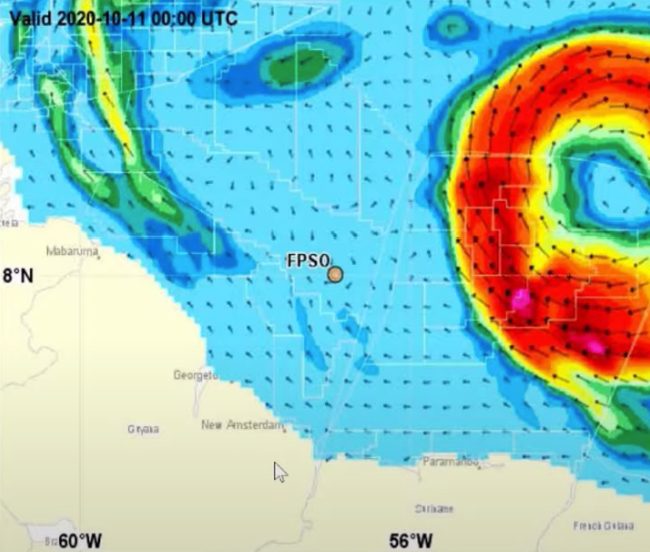
Martelli spoke about four pillars that are key to frontier project development: management, understanding the needs and risks associated with the project; planning, specifically for the unplanned such as political, socioeconomic and infrastructure challenges; strength, selecting best-in-class assets and resources and verify the robustness of plans; and long-term and strategic relationships, including with training institutions.
“With a direct relationship with training institutions, you create employment, develop skills and training programs that specifically enhance capacity and foster the growth of local reliable partners in compliance with technical and quality standards,” he said.
Forming partnerships is also crucial for companies looking to grow. That’s the case for Suriname’s state oil company Staatsolie, which is aims to become an offshore operator in shallow water and a deepwater partner.
“We have the opportunity to participate in around about 20% in any of the discoveries that will be made in the deepwater offshore Suriname,” said Brian Glover, vice president of Staatsolie, “and we want to be able to stand shoulder to shoulder with our joint venture partner.”
The company has served as operator onshore but envisions transferring its learnings offshore, where bigger players like Apache Corp. have had made discoveries along what Glover said could be called “The Golden Highway” that extends from neighboring Guyana.
Staatsolie launched a bidding round for offshore blocks on Nov. 16, providing another opportunity for companies to jump into an emerging area.
“This [area] lies between the discoveries that we’ve seen in the deep water and, of course, our producing fields in the onshore,” Glover said. “So, it does represent significant exploration opportunity.”
Recommended Reading
Mexico Pacific Appoints New CEO Bairstow
2024-04-15 - Sarah Bairstow joined Mexico Pacific Ltd. in 2019 and is assuming the CEO role following Ivan Van der Walt’s resignation.
Marathon Petroleum Sets 2024 Capex at $1.25 Billion
2024-01-30 - Marathon Petroleum Corp. eyes standalone capex at $1.25 billion in 2024, down 10% compared to $1.4 billion in 2023 as it focuses on cost reduction and margin enhancement projects.
Marathon Chasing 20%+ IRRs with Los Angeles, Galveston Refinery Upgrades
2024-02-01 - Marathon Petroleum Corp. is pursuing improvements at its Los Angeles refinery and a hydrotreater project at its Galveston Bay refinery that are each boasting internal rate returns (IRRs) of 20% or more.
NGL Growth Leads Enterprise Product Partners to Strong Fourth Quarter
2024-02-02 - Enterprise Product Partners executives are still waiting to receive final federal approval to go ahead with the company’s Sea Port Terminal Project.
Enbridge Advances Expansion of Permian’s Gray Oak Pipeline
2024-02-13 - In its fourth-quarter earnings call, Enbridge also said the Mainline pipeline system tolling agreement is awaiting regulatory approval from a Canadian regulatory agency.


